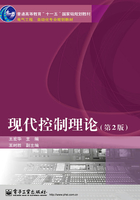
2.7 连续状态方程的离散化
众所周知,数字计算机只能处理数字信号,其不仅在数值上整量化,且在时间上离散化。正是由于数字计算机的这一特点,在以下两种问题研究中需要将连续状态方程离散化,其一以数字计算机为核心的数字控制系统的分析与综合;其二以数字计算机为工具求连续状态方程的数值解。
典型的计算机数字控制系统结构框图如图2-1所示。

图2-1 计算机数字控制系统结构框图
图2-1中,被控对象G(s)为线性定常连续系统,其状态空间表达式为

连续被控量y(t)经检测环节的输出f(t)仍为连续量,由于数字控制器不处理连续信号,应将f(t)经采样和A/D转换成为离散数字反馈量f(kT),而模拟给定r(t)也经采样和A/D转换成为离散数字给定量r(kT)。r(kT)减f(kT)形成离散数字误差信号e(kT),e(kT)经数字控制器处理得到离散数字控制信号u(kT),u(kT)经D/A转换和保持器成为被控对象所需的连续控制信号u(t)。
可见,为了对计算机数字控制系统运用离散控制系统理论进行分析与综合,需要对连续被控对象离散化,由式(2-83)推出采样时刻t=kT时等效描述x(kT)、y(kT)与u(kT)的差分型状态空间表达式,即

由于输出方程描述的是输出与状态向量和控制向量的某种线性组合,其组合关系并不因离散化而改变,因此,离散化后输出矩阵C和输入/输出关联矩阵D保持不变,离散化的输出方程可直接写出。
另一方面,在已知各状态变量初始值的条件下,将连续状态方程离散化,应用数字计算机可十分容易地从初始时刻递推求出各采样时刻的状态变量值,得到连续状态方程近似数值解,从而避免数值积分方法繁琐的求解计算。事实上,连续状态方程离散化已成为连续系统离散相似法数字仿真的基础。
线性连续状态方程的离散化有求系统脉冲传递函数的频域离散化方法和时域中采样保持的离散化方法,本节只讨论时域中线性连续系统的离散化。
2.7.1 线性定常连续状态方程的离散化
为了将式(2-83)描述的线性定常连续系统离散化变成式(2-84)描述的等效离散系统,在系统的输入、输出端人为地加上理想采样器,且为使采样后的输入控制量u(kT)复原为原来的连续信号,在输入信号采样器后加保持器,如图2-2所示,并假设:采用周期采样,采样周期T的选择满足Shanon采样定理;保持器为零阶保持器,即假设输入控制量u(t)为仅在采样瞬时变化而在采样间隔内保持不变的阶梯形信号。

图2-2 线性连续系统的离散化
下面考察阶梯形输入控制作用下式(2-83)所示线性定常连续系统如何由t0=kT时刻的状态x(kT)转移到t=(k+1)T时刻的状态x[(k+1)T],由此求其等效差分型状态方程中的G(T)和H(T)。
由式(2-42),连续系统状态方程的解为

式中,令t0=kT,t=(k+1)T,有

由于假设在一个采样周期内输入信号保持不变,即
u[kT≤t<(k+1)T]=u(kT)
故式(2-85)中的u(τ)=u(kT)且可提到积分号外,并与式(2-84)中的等效差分型状态方程比较得

式中


在式(2-88)中,引入新积分变量t=(k+1)T-τ,则原积分下限τ=kT对应于t=T,原积分上限τ=(k+1)T对应于t=0,且dτ=-dt,则式(2-88)简化为

式(2-86)、式(2-87)、式(2-89)为线性定常连续状态方程离散化公式。显然,G(T)和H(T)与采样周期有关,当采样周期T确定后,其为常数阵。
应该指出,式(2-86)是在假定连续系统输入是零阶保持器的输出(即输入信号在一个采样周期内保持不变)的前提下推出的。若实际输入信号在一个采样周期内是变化的,这时式(2-86)只是近似离散化公式,为了减小误差,在图2-2中可用一阶保持器取代零阶保持器(即假定在两个采样时刻之间输入信号为一斜坡函数),重新推导式(2-85)中的积分项。需要指出,尽管一阶保持器复现原信号的准确度较零价保持器高,但其相角滞后较零阶保持器大,对系统的稳定性更不利,因此实际工程中,一般很少使用一阶保持器,而普遍使用零阶保持器。
2.7.2 线性时变连续状态方程的离散化
仿照定常系统,线性时变连续状态方程离散化仍采用周期采样的离散方式,采样周期为T,同时采用零阶保持器。
设线性时变连续系统状态空间表达式为

由式(2-68)知,式(2-90)中的状态方程的解为

式中,令t0=kT,t=(k+1)T,且注意到u[kT≤t<(k+1)T]=u(kT)(基于输入是零阶保持器输出的假设),有

式中


式(2-92)、式(2-93)、式(2-94)即为线性时变连续状态方程离散化公式,而输出方程的离散化可以t=kT代入式(2-90)中的连续输出方程直接得出

因线性连续系统的状态转移矩阵非奇异,故式(2-87)和式(2-93)表明,不论线性连续系统的系统矩阵A和A(t)是否非奇异,采用采样保持的离散方式导出的等效离散化系统的系统矩阵G(T)和G(kT)必为非奇异。
由于线性时变连续状态方程的状态转移矩阵Φ(t,t0)通常得不到闭合形式的解析式,为此在采样周期很小且计算精度要求不高的前提下,常采用式(2-96)所示的近似离散化状态方程,即

式(2-96)是用差商近似微商推出的,即

又由线性时变连续系统状态方程得

则有

整理上式即得式(2-96)。可见,采用近似离散化方法,G(kT)、H(kT)分别可近似表示为


显然,采样周期越小,近似离散化的精度越高。以上近似离散化方法显然也适用于线性定常连续系统。不过,采用近似离散化方法得到的离散化系统矩阵并不保证是非奇异的。
【例2-11】 系统结构图如图2-3所示。

图2-3 例2-11系统结构图
(1)试求系统离散化的状态空间表达式。
(2)试求当采样周期T=0.1s,输入为单位阶跃函数,且初始状态为零时的离散输出y(kT)。
解(1)连续被控对象的传递函数为

连续被控对象的状态空间表达式可按能控标准型列出,即

由例2-4知,上式对应的状态转移矩阵为

由图2-3知,连续被控对象的输入是零阶保持器Gh(s)=(1-e-Ts)/s的输出,满足式(2-86)的假定前提,则根据式(2-87)、式(2-89)得


故连续被控对象的离散化状态空间表达式为

由系统结构图可见,u(kT)=r(kT)-y(kT),又y(kT)=x1(kT),则u(kT)=r(kT)-x1(kT),将其代入连续被控对象的离散化状态空间表达式,可得闭环系统离散化的状态空间表达式为

(2)令采样周期T=0.1s,闭环系统离散化的状态空间表达式为

由题意,r(kT)为单位脉冲序列1(k),初始状态为零,现采用递推法求状态方程的序列解为




则离散输出y(kT)为
y(0)=x1(0)=0,y(0.1)=x1(0.1)=0.005,y(0.2)=x1(0.2)=0.017,
y(0.3)=x1(0.3)=0.034,y(0.4)=x1(0.4)=0.055,…
事实上,本题离散输出y(kT)也可用系统脉冲传递函数求得,即

其中

令采样周期T=0.1s,代入得

则

又因为输入r(t)为单位阶跃函数,则R(z)=z/(z-1),则

则离散输出y(kT)为
y(0)=0,y(T)=y(0.1)=0.005,y(2T)=y(0.2)=0.018,y(3T)=y(0.3)=0.036,
y(4T)=y(0.4)=0.057,…
【例2-12】 已知线性时变系统的状态方程为
 ,
,
输入为单位阶跃信号u(t)=1(t),试采用近似离散化方法求其近似离散化状态方程及当采样周期T=0.1s时状态向量x(t)在采样时刻kT(k=1,2,…)的近似值。
解 根据式(2-97)、式(2-98)有


则得近似离散化状态方程

取T=0.1s,应用递推法解以上近似离散化状态方程,可得状态向量x(t)在采样时刻的近似值,即

可以验证,由于采样周期较小,近似离散化的精度较高。应该指出,对线性时变系统,通常难以求出闭合形式的状态转移矩阵Φ(t,t0)的解析式,故常采用近似离散化方法。事实上,对难以求取Φ(t,t0)的线性时变连续系统,在采样周期较小的条件下,可采用近似方法将其离散化,再应用递推法即可求得系统状态向量x(t)在各采样时刻的近似值。